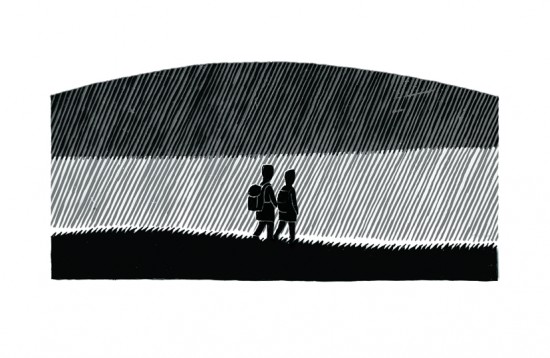 illustration by Jon McNaught.
illustration by Jon McNaught.
An extract from the new Caught by the River book, On Nature.
Being in a band generally involves touring great distances all over the world, sometimes through truly spectacular landscapes such as the Nevada Desert, the canyons of Utah, the Alps and the mountains of Taiwan. Being captive for such long durations, staring through the window at these magical scenes, can really drive you crackers. It certainly develops a strong urge to get out there, in amongst it. So, after finishing a lengthy spell of touring, I had a week off in early spring 2009, and decided to go walking in England with my girlfriend. We decided to walk the Two Moors Way (TMW) which crosses Dartmoor and Exmoor, 103 miles north to south, linked by the Exe Valley in the middle. The TMW traverses a variety of stunning landscapes including large stretches of open moorland, rural villages and deep wooded river valleys. Dartmoor also boasts more prehistoric remains than any other National Park in Europe, and Exmoor possesses a rich variety of wildlife.
We started in Ivybridge, South Dartmoor and headed north to Lynmouth, on the North Exmoor coast.
Day 1) Ivybridge–Scorriton (14 miles)
Sunday 22nd March 2009
Having breakfast cooked for you is always a great way to start the day. Baked beans, toast, bacon, eggs and a nice cup of tea. Bellies full, bags packed and a clear sky above, we passed the old paper mill and headed out of Ivybridge.
A gentle ascent over fields and up stony paths led us to the edge of Dartmoor. From here, we followed the remains of a disused Redlake Tramway, which once served a china clay works. Out of breath, blood pumping and feeling good, we reached the top of the moor. With the cold wind blowing in my face, it instantly struck me how barren it was. Dartmoor was a desert of dried grass. No purple heather. No coconut-scented gorse blossom. The yellow blanket of moorland hay was a stunning contrast to the vast blue sky. Although seemingly lifeless, Skylarks climbed the air, trilling and chattering. Further on, a startled Snipe sprang up and flew into the distance. Within a couple of hours we were in the heart of Dartmoor, without a sign of civilisation. A heavily pregnant Dartmoor Pony wandered up to us for a ‘chat’ and a nibble of our food.
Our first sighting of Dartmoor’s famous prehistoric remains was a stone row. Stretching 300 metres in front of us, it looked like a set of giant granite dominos waiting to be knocked over. A Wheatear, looking like a masked highwayman of the moors, led us down the track a few hundred metres before retracing its journey and flashing its white rump. (Its name refers to the prominent white rump – ‘wheat’ derived from ‘white’, and ‘ear’ meaning ‘arse’.)
After some lunch, we descended into a valley where the river Avon ran. Stagnant puddles lay at the sides of the river, overpopulated with thousands of two-legged tadpoles, standing on each other’s heads, gasping for oxygen. This part of the walk took us on a section of the ‘Abbots Way’, which serves Buckfast Abbey. The monks there still make ‘Buckfast Tonic Wine’, a favourite tipple and ‘badge of honour’ of Scottish underage drinkers. It was almost banned in Scotland, prompting ‘Don’t Ban Buckie’ demonstrations. It was easy to imagine monks trundling through these moors, tipsy, laughing and spilling Buckfast down their tunics. At a ford further on a pair of Stonechats were stationed on some mill ruins. Their striking tricolour plumage of orange-red breast, black head and white patches on their necks was very clear at such close quarters. We stopped and watched them feed, hovering, fluttering and dropping to the ground to pick up food, before returning to the mill ruins to eat their catch.
The final mile took us past two pot-bellied pigs in their little mucky haven. They trotted over, snuffling for food and a good old head scratch. On the descent into Scorriton there were beautiful views across the valley to Buckland Beacon and Rippon Tor. It was a lovely end to the day’s walk.
We arrived at 5 p.m. as the sun was starting to set. Our B&B room was decorated in the ‘country twee meets medieval boudoir’ style, which was slightly bewildering. Over at the village pub, we considered the next day’s walk, which was six miles longer than today’s. It wasn’t yet British Summer Time, so to avoid walking in the dark we’d have to set off early in the morning. We raised our glasses of ‘Jail Ale’ to the nearby category C prison, HM Prison Dartmoor, and then headed back to our B&B. The night sky was full of shining stars.
Martin will be discussing his walk with Luke Turner at a book launch event in London on July 6th. Click HERE for details.